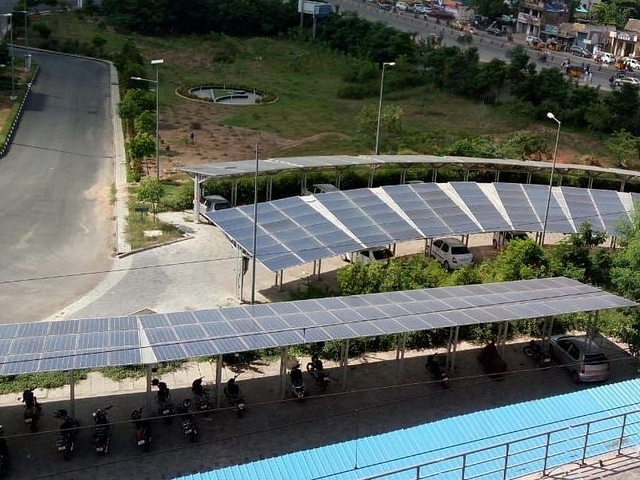
Ground Report: Chennai Metro Rail Goes Solar To Cut Energy Costs
Use of renewable energy is key to Chennai Metro’s financial health, and with solar power panels installed at its various premises, it is headed in the right direction.
The Chennai Metro Rail Limited (CMRL) administrative office at Koyambedu is a stone’s throw from the Koyambedu Metro Rail Station. There is nothing unique about the administrative building. But there is something special about the car parking sheds there.
Atop the CMRL administrative office car parking sheds are solar power panels that help the organisation meet a part of its electricity demands. It is not just at its headquarters but also on rooftops of its stations – elevated and underground, CMRL has put up solar power panels to generate electricity.
“Currently, CMRL is producing 2.1 Mega Watt peak (MWp) of solar power. By the end of the current financial year, the organisation hopes to generate 4.5 MWp,” says CMRL public relations officer S Pandian.
Chennai Metro Rail, a joint venture of the Union and state governments, will continue to install more rooftop solar power panels as stations get ready. Most of the panels have been installed atop the railway stations. The organisation has also installed the panels on top of its rail depot at Koyambedu. It plans to install 80 per cent of the panels on the rooftop and the rest on the vacant land inside its depot at Koyambedu.
CMRL is using the latest version of solar panels, inverters, mounting methods and monitoring systems. The system is monitored through remote system, approved by Solar Energy Corporation of India and Ministry of New and Renewable Energy.
Chennai Metro operates two stretches – Green and Blue lines – currently. The Green Line starts from Chennai Central and ends at the Chennai International Airport. This became fully functional from 25 May this year, after the late Jayalalithaa inaugurated it on 21 September 2016 – the last function she took part in. The Blue Line will operate from the airport to Washermanpet. Currently, it operates between airport and Accountant General/Directorate of Medical Services offices at Teynampet.
A feature of Chennai Metro’s objective to achieve energy security and reduce carbon energy is that the solar power panels are being installed at no upfront cost for the organisation. “All our solar power plants are installed under zero capital investment,” said Pandian.
CleanMax Solar, a Bengaluru-based firm that is a pioneer in ‘energy sale” model, is putting up the solar power panels that can generate 6 MWp atop the the Chennai Metro stations. The business model of CleanMax Solar has come in handy for Chennai Metro to not invest any money upfront for the solar power panels installations.
The Bengaluru firm’s model is to install the solar power panels with its own investments at the customers’ premises – Chennai Metro in this case. It will then sell the power that is produced to Chennai Metro at a cost that is lower compared to what it would have to pay the Tamil Nadu Electricity Board. The mode of project execution is the same as that of Kochi Metro, which meets 25 per cent of its power needs through solar power generation with all its 22 stations sporting rooftop solar power panels.
Given the solar power panels installed at its various premises, Chennai Metro Rail will be able to save Rs 75 lakh a year through purchase and consumption of solar power. CleanMax sees the savings rising to about Rs 1.5 crore a year.
Pandian says the entire power generated is utilised by Metro Rail, whose demand is huge. In August this year, Chennai Metro said renewable power – solar and wind – would make up 80 per cent of its power purchase. Then, it said it was paying Rs 8 per unit of electricity to Tamil Nadu Generation and Distribution Corporation that supplies power to it. Purchase of renewable power would help it to cut its energy costs to Rs 3.50 per unit.
Use of renewable energy is key to Chennai Metro’s financial health as it needs electricity for lighting and escalators at its stations. The underground stations consume double the energy to run air-conditioners and ventilators. Energy costs typically make up 30 per cent of the operation costs. The organisation saves 30 per cent of its power through regenerative braking system used by its trains which produce power whenever brakes are applied.
Since CleanMax installs the panels and sells the power generated from it, Chennai Metro also saves costs on maintaining panels. Going forward, the organisation will try to generate maximum solar power and meet the Centre’s target of producing 20 MWp, says Pandian.